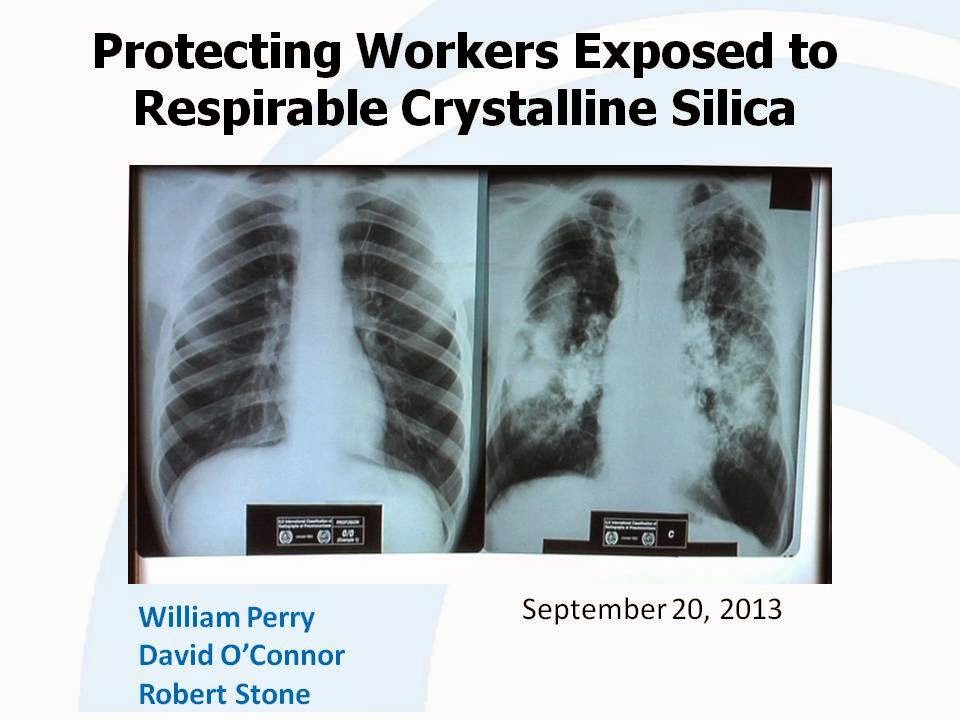
Asbestos is one tragedy, silicosis another. It came before and is comparable to the asbestos
disaster by the sheer number of victims. Sadly, lessons were not learned.
In European countries, many workers still bear the legacy of coal mining. In 2009,
figures from the annual report of Belgium’s Occupational Diseases Fund (FMP) indicate
that up to 10 000 workers are receiving compensation for silicosis and silicosis combined
with pulmonary tuberculosis. In Germany, 1 097 new cases of silicosis and 3 cases of silicosis
combined with pulmonary tuberculosis were recognised in 2011.
Like asbestos diseases, silicosis is an irreversible lung disease. It is caused by exposure
to crystalline silica dust, the main form being quartz. Exposure to silica occurs mainly
during milling, sawing, drilling or polishing stone materials that give off respirable quartz
dust. The amount of quartz dust given off during these operations depends on the composition
and nature of the material.
Respirable quartz dust is very fine, barely visible. It consists of tiny insoluble particles
that penetrate deep into the lungs. It is these fine particles that can cause silicosis.
There are several types of silicosis: acute silicosis from massive exposure can cause death
within three years; so-called early forms can appear within five years; delayed forms can occur
after several years’ exposure, sometimes many years after the last exposure. Silicosis is a
progressive and irreversible incapacitating disease. Crystalline silica can also cause chronic
obstructive bronchitis. And that is not the whole story.
In 1996, the IARC put crystalline silica on its list of known human carcinogens, being
of the opinion that it could cause lung cancer.
Industries where workers are exposed to crystalline silica abound. They include:
mining, quarrying, ceramics, glass, cement and pre-cast concrete, natural stone, foundries,
jewellery, dental prostheses and all parts of the construction industry.
Many building trades are concerned: asphalters, concrete workers, screed layers,
bricklayers, plasterers and plasterboard fitters, demolition workers, tilers, pavers, etc.
An EU-wide survey done in the early 1990s (Carex, Carcinogen Exposure) indicated
that crystalline silica was among the most common workplace carcinogens.

The survey estimatedthat over 3.2 million
workers were affected in the Europe of Fifteen, 87% of themin the construction industry. A million workers were exposed to crystalline silica dust inGermany, about half a million in the UK and another half-million in Spain.
Crystalline silica is still not classified as carcinogenic in the European Union. In December
2012, the European Advisory Committee on Safety and Health at Work (ACSH)
adopted an opinion calling for the Carcinogen Directive to be revised (see Chapter 4) to add
EU-wide binding occupational exposure limit values (OELVs) for 20 substances, including
 crystalline silica. The OELV for crystalline silica proposed by the Scientific Committee for
crystalline silica. The OELV for crystalline silica proposed by the Scientific Committee forOccupational Exposure Limits to chemicals (SCOEL) is 50 mcg/m3
(micrograms per cubicmetre). That proposal was made in 2003. It corresponds to the recommendation made in
1974 by the U.S. Institute for Occupational Safety and Health (NIOSH). Despite the health
21
issues involved, the European Commission has still not put forward a binding limit value
for exposure to silica. In August 2013 – 30 years after NIOSH first recommended it – the
50 mcg/m3
standard finally featured in a bill put up by the U.S. Occupational Safety and
Health Administration (OSHA), whose director claims that applying the standard could
save 700 lives and prevent 1 600 new cases of silicosis each year in the United States.
In Germany, where lung cancer caused by crystalline silica is a recognised occupational
disease, 898 cases were compensated between 1978 and 2010, and 69 new cases in
2011. Also in 2011, Germany compensated 2 000 cases of silicosis.









0 comments:
Post a Comment